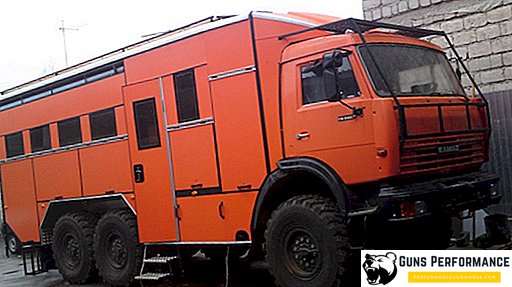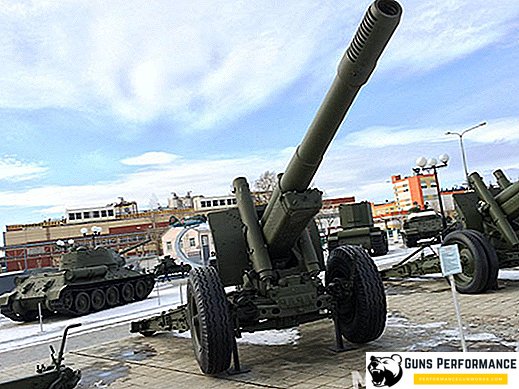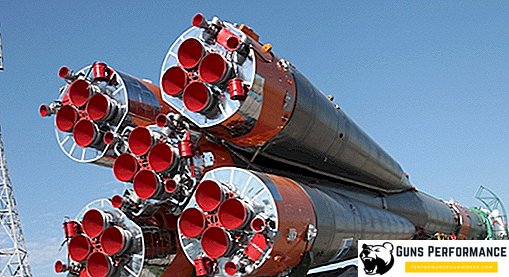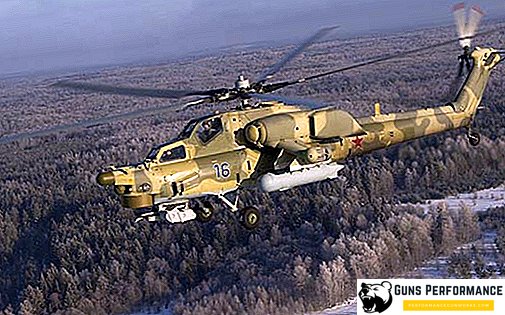
AGS-17 "Flame" - this is a Soviet machine-gun automatic grenade launcher, which was developed in the OKB-16 (now it is the Nudelman Design Bureau), and was adopted in 1970. It is intended for the destruction of enemy infantry, located both openly and behind the natural folds of the terrain (on reverse slopes, in ravines, hollows), as well as in open field fortifications (trenches, rifle cells). The caliber of AGS-17 grenade launcher is 30 mm.
The AGS-17 "Flame" mounted grenade launcher is a powerful anti-personnel weapon, with excellent tactical and technical characteristics. He can hit the enemy with both mounted and table fire. The grenade launcher is still in service with the Russian army, in addition, the AGS-17 is operated in the armed forces of another two dozen countries of the world (the former Soviet republics, the PRC, Iran, India, Finland, the DPRK and others).

The strengths of the AGS-17 are its simplicity, reliability and versatility - the grenade launcher can be used not only from the machine, but also installed on various types of military equipment, including helicopters.
AGS-17 "Flame" is a formidable and effective weapon, proven in dozens of conflicts. His baptism of fire was Afghanistan. This grenade launcher perfectly proved itself during the fighting in the mountains. AGS-17 was "respected" not only by the Soviet fighters, the Mujahideen also used trophy samples of these weapons with great pleasure. AGS-17 passed the first and second Chechen campaigns and other local conflicts that erupted on the territory of the former Soviet Union, now the grenade launcher is actively used in Syria.

Serial production of an automatic grenade launcher AGS-17 was established at the machine-building plant "Molot", currently there are several modifications of this weapon. In addition, AGS-17 was produced in China and in the former Yugoslavia.
History of creation
The first automatic AG-TB grenade launcher was developed in the USSR by a talented gunsmith Taubin in the early 1930s. The idea of combining the rate of fire of an automatic weapon with the striking effect of fragmentation ammunition seemed very successful. A new type of weapon interested the military, prototypes were made and tests were conducted.
The AG-TB grenade launcher even managed to take part in the Winter War. There were plans to install new weapons on combat boats, aircraft, armored vehicles. But, in the end, the 50-mm Shavyrin mortar was put into service, and work on automatic grenade launchers was stopped.
However, thanks to the AG-TB project, OKB-16 appeared, headed by Jacob Taubin.
For a long time in the USSR, automatic grenade launchers did not pay enough attention. Only after the Americans successfully began using the Mk 19 automatic mounted grenade launcher in Vietnam, did the Soviet military think about creating a counterpart.
The development of the grenade launcher was entrusted to the same OKB-16, however, at this time it was no longer Taubin who was in charge of it, but his student and follower Nudelman. The project was headed by Alexander Fedorovich Kornyakov.

In 1967 the shooting model of the weapon was ready, it received the name AGS-17. After some modifications and tests, in 1971 the Soviet army adopted a new type of small arms.

It should be noted that the construction and according to the classification prevailing in the Soviet Union, AGS-17 "Flame" is a small-caliber automatic weapon. Accordingly, his shot is a small-caliber artillery cartridge with a high-explosive fragmentation projectile. The name of the weapon ("automatic grenade launcher") is more associated with tactical tasks that it performs on the battlefield and is not due to its design. Together with the grenade launcher, automatic grenade launchers formed a new class of weapons - "weapon of support".

In combat conditions AGS-17 was used for the first time during the Vietnam-China conflict in 1979. The real test for this weapon was the war in Afghanistan, and I must say that AGS-17 brilliantly passed it. Often there were cases when the Flame grenade launchers independently welded to the body of an armored vehicle, greatly increasing its combat power.
The first modifications of the weapon had a barrel with an aluminum radiator for cooling; later, its function began to perform the fins of the outer surface of the barrel.
Description of construction
Automatic equipment AGS-17 works due to rollback of the free shutter. The use of such a scheme allows a small barrel length, a weak propellant charge of a grenade and a small muzzle energy of ammunition. The design of a grenade launcher consists of the following elements: a trigger mechanism, a receiver, a box with a barrel, a bolt, a reloading mechanism, and return springs.

AGS-17 has a rifled barrel that can be quickly replaced, it is attached to the receiver with checks and a contactor. The rectangular bolt of the grenade launcher is equipped with a rammer, which moves vertically, and a comb, which extracts the spent cartridge case. Inside the shutter there is a hydraulic recoil brake, which increases the automation cycle, thereby increasing the accuracy and accuracy of fire. The brake includes a cylinder with kerosene, a piston rod and a flange that prevents fluid from flowing out. When you roll back the hydraulic brake rests on the butt of the weapon, and when moving forward - in special projections of the receiver.
In the gate channel are two return springs.
In the cover of the receiver AGS-17 placed reloading mechanism, consisting of a holder and a cable with a T-shaped handle. When pulling the cable, the bolt is pulled back. When firing from AGS-17, the reloading mechanism remains stationary.
Impact mechanism of the easel grenade launcher - kurkovy type. During the descent of the trigger hits the lever of the striker, located in the gate. The trigger mechanism is located on the left side of the receiver.

AGS-17 is equipped with a flag-type fuse that locks the trigger sear. The grenade launcher has a mechanism for adjusting the rate of fire. It works through a change in the duration of the weapon’s automatic operation cycle.
The flag with which you can change the rate of fire has two fixed positions: the top one is 350-400 shots / min. and lower - 50-100 shots / min.
To control the AGS-17 grenade launcher, two horizontal folding handles are used, the trigger lever is located between them.
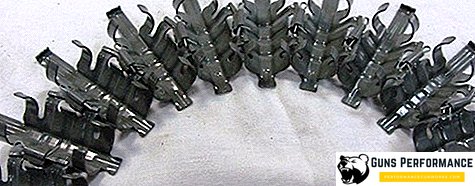
The power supply of AGS-17 is tape, the grenade launcher belt is link metal, it has an open link. It fits into a round box, which is attached to the right side of the receiver. The belt feed mechanism consists of a spring-loaded feeder and a feed lever with a roller. Used sleeve is extradited from the receiver with a special reflector down.
The tape for shots is equipped either manually or with a special machine. A standard ribbon with 29 shots is placed in the box. The capacity of the tape is 30 shots, but it does not have a shank, so its role is played by the extreme link, which is put in the receiver.
The tape box has a carrying handle, a lid and a sash with latches, as well as a special curtain that closes the neck during transport.
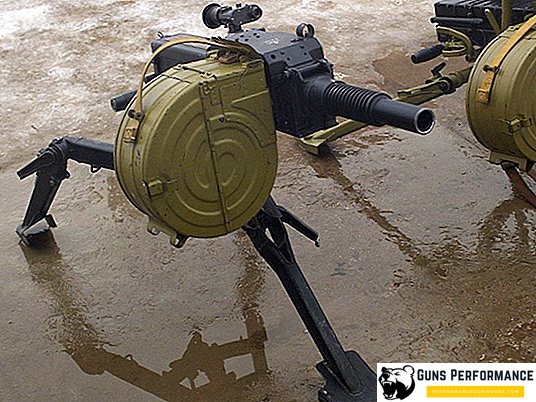
For pointing weapons using a PAG-17 riflescope, which is installed with a bracket on the left side of the receiver. Sights allow direct fire at a distance of 700 meters, they can also be used when shooting from closed positions. In addition to the optical, the grenade launcher is equipped with a mechanical sight, which consists of a front sight and a rear sight.
For the installation of AGS-17 is used the machine SAG-17. In the stowed position, the SAG-17 is folded and usually moves with the second number of the calculation. All machine supports are adjustable, which makes the use of a grenade launcher convenient in any situation.

For firing AGS-17 can use several types of shots, most often used VOG-17 and VOG-17M. Each of these shots consists of a liner, a powder charge, a grenade and an instantaneous fuse. The grenade has a thin-walled case with a rectangular section laid inside a notched wire. After impaling the capsule, the powder charge in the cartridge case is ignited and a shot is fired. The fuse becomes a combat platoon only after 50-100 meters of flight, which ensures the safety of the calculation.
VOG-17M is a modernized grenade equipped with a self-destruction mechanism. In addition to combat, in the grenade launcher ammunition may include practical shots. For example, VUS-17, which instead of explosive contains pyrotechnic composition, giving orange smoke at the site of the fall. Training ammunition has also been created for AGS-17.
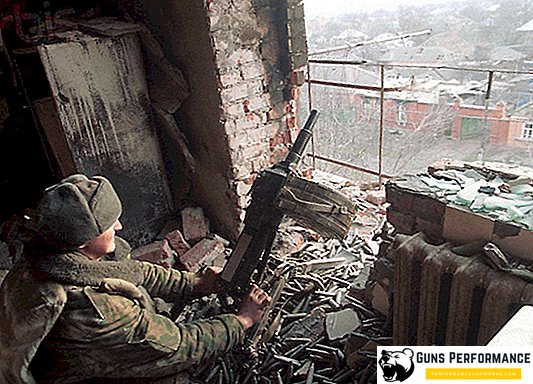
The shots for the AGS-17 grenade launcher were developed at NPO Basalt. Several more types of ammunition were created by foreign companies.
Modifications
Currently, there are several modifications of AGS-17:
- AGS-17 "Flame". This is a basic modification of the weapon, which is installed on the SAG-17 tripod machine.
- AP-30 "Flame-A". Aircraft modification of a grenade launcher, developed in 1980. This option differs from the base by the presence of the electric trigger, the counter of shots, a slightly reduced step of cutting in the bore and a high rate of fire. Accordingly, the AP-30 had to be equipped with a more massive barrel cooling radiator. This version of the grenade launcher is usually housed in a special hanging container.
- AG-17D. Modification mounted on the Terminator infantry support vehicle
- AG-17M. The marine version of the grenade launcher, which is designed for installation on boats, is also used on the BMP-3.
- KBA-117. Modification of a grenade launcher developed by Ukrainian designers of the Design Bureau Artillery Armament. It is part of the combat modules of armored vehicles and armored boats.
Exploitation
The calculation of AGS-17 consists of two people, the ammunition carrier may also be included in the calculation. As a rule, shooting is carried out in automatic mode, although it is possible to conduct single fire. The most effective shooting in short bursts (3-5 grenades).
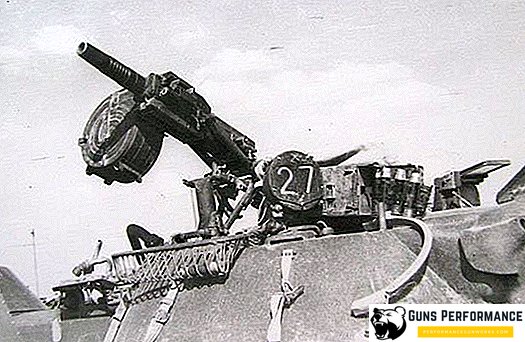
In combat, the movement of the grenade launcher is made with the machine, for this you can use special belts. It should be noted that this weapon weighs a lot - 18 kg, and together with the machine - 52 kg. And that's not counting grenade launcher ammunition. This fact can be called the main drawback of the grenade launcher. In general, we can say that AGS-17 is a reliable and effective weapon, quite simple in operation. Its disassembly does not require additional tools and can be carried out in the field. All of the above qualities have been repeatedly tested during the many wars and conflicts of recent decades. For most of its characteristics, AGS-17 confidently surpasses its foreign counterparts.
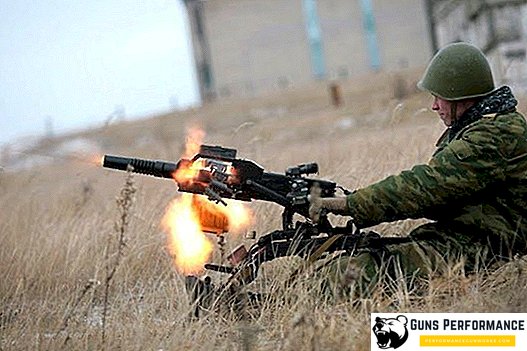
Specifications
The following are TTX AGS-17.
| Caliber, mm | 30 |
| Barrel length, mm | 290 |
| Overall length, mm | 840 |
| Total weight, kg | 18 |
| Weight with machine, kg | 52 |
| Rate of fire, rds / min | 65 |
| Radius of continuous damage, m | 7 |
| Rate of fire, rds / min | 100 |
| Initial speed grenades, m / s | 120 |
| Battle calculation, pers. | 2-3 |
| Sighting range, m | 1700 |


